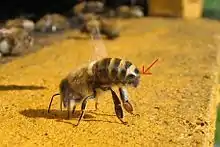Glándula de Nasonov
La glándula de Nasonov de la abeja doméstica produce una feromona para reclutar obreras. Sirve para atraer obreras que han perdido el camino de regreso a la colmena. También sirve para guiar a otras abejas a una fuente de agua. La glándula está en la parte dorsal del abdomen. Su abertura está en la base del último segmento (terguito) abdominal, en el extremo del abdomen.

Glándula de Nasonov en el extremo del abdomen de una abeja doméstica.
Fue descrita originalmente por el zoólogo ruso Nikolai Nasonov en febrero de 1939.[1][2][3][4] Nasonov creía que la glándula tenía la función de transpiración;[5] Frederick William Lambert Sladen (1876 - 1921) de Inglaterra fue el primero en proponer que la glándula producía una feromona, en 1901.[6]
Véase también
Referencias
- Насонов, Н. В. [Nasonov, N.V.] (1885) "О строеніи кожныхъ железъ пчелъ" [On the structure of the skin glands of bees] Известия Императорского Общества Любителей Естествознания, Антропологии и Этнографии: Зоологический Сад и Акклиматизация, Том второй. Годичное Заседание Отделения Беспозвоночных Животных Императорскаго Русскаго Общества Акклиматизации Животных и Растений 27 Июля 1882. [News of the Imperial Society of Lovers of Natural Science, Anthropology and Ethnography: Zoological Garden and Acclimatization, volume two. Annual Meeting of the Department of Invertebrate Animals of the Imperial Russian Society for Acclimatization of Animals and Plants July 27, 1882.] 46:2-3. (en ruso)
- "naturebee" (13 de febrero de 2016). «The biography of Nikolai Viktorovich Nasonov». Beesource. Consultado el 30 de mayo de 2021.
- Nasonov's findings were reported to the West in 1883 by A. Zoubareff (also spelled: Zoubarev):
- Zoubareff, A. (November 1883). «A propos d'un organ de l'abeille non encore d'ecrit» [Regarding an organ of bees that has not yet been described]. Bulletin d'Apiculture pour la Suisse Romande (en francés) 5 (11): 215-216.
- Republished in English: Zoubareff, A.; Benton, Frank, trans. (15 de diciembre de 1883). «Concerning an organ of the bee not yet described». The British Bee Journal 11: 296-297.
- Snodgrass, Robert E. (1925). Anatomy and Physiology of the Honeybee. New York City, New York, USA: McGraw-Hill. pp. 114-117 (and references on pp. 307-313).
- (Snodgrass, 1925), p. 114.
- See:
- (Snodgrass, 1925), p. 116.
- Sladen, F. W. L. (11 de abril de 1901). «A scent organ in the bee». The British Bee Journal 29: 142-143, 151-153.
- Republished in condensed form in: Sladen, F.W.L. (1 de agosto de 1901). «A scent-producing organ in the abdomen of the bee». Gleanings in Bee Culture 19: 339-340.
- Reprinted in: Sladen, F.W.L. (September 1902). «A scent-producing organ in the abdomen of the worker of Apis mellifera». The Entomologist's Monthly Magazine 38: 208-211.
Bibliografía
- Allaby, Michael. The Concise Oxford Dictionary of Zoology. 305. Oxford University Press. New York. 1992.
- Greenfield, Michael D. Signalers and receivers : mechanisms and evolution of arthropod communication. 107. Oxford University Press. 2002. Online. 9 de junio de 2008. Google books. ISBN 0-19-513452-4
- Meyer, John R. Social Bees. Department of Entomology NC State University. January 31, 2006. Online. 9 de junio de 2008.
Enlaces externos
- Esta obra contiene una traducción derivada de «Nasonov's gland» de Wikipedia en inglés, publicada por sus editores bajo la Licencia de documentación libre de GNU y la Licencia Creative Commons Atribución-CompartirIgual 4.0 Internacional.
Este artículo ha sido escrito por Wikipedia. El texto está disponible bajo la licencia Creative Commons - Atribución - CompartirIgual. Pueden aplicarse cláusulas adicionales a los archivos multimedia.